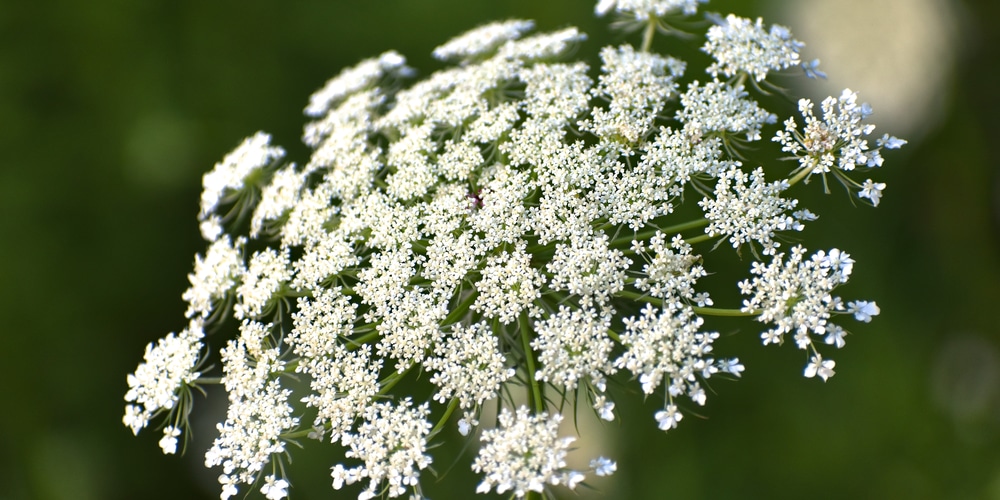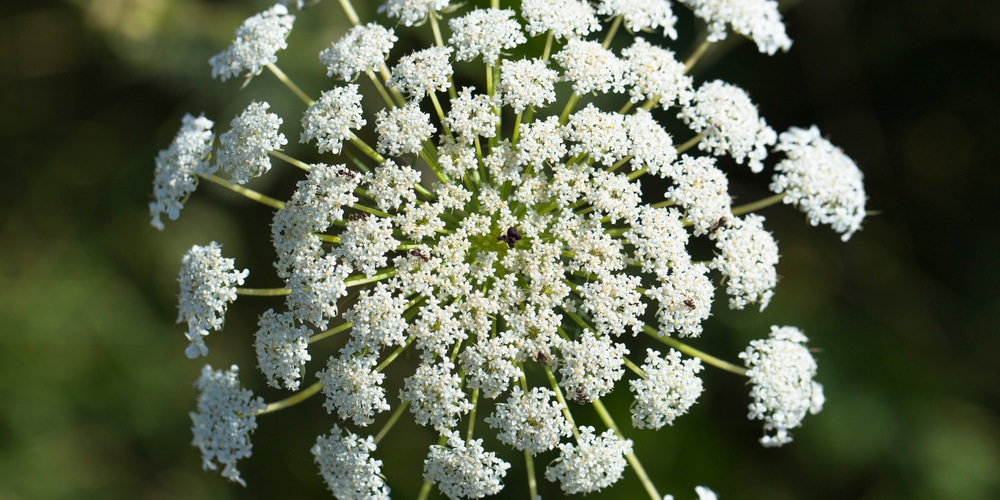Plants throughout the world have lookalikes. At times the doppelgangers are inconsequential, but some cases of lookalike plants can have serious consequences. Read below to learn more about the differences between Poison Hemlock vs Queen Anne’s Lace.
Poison Hemlock
Hemlock has quite the reputation for being Poisonous, so its full moniker comes as no surprise. Legends say that a brew made with this plant was chosen by Socrates, as a way for him to take his execution into his own hands. Poison Hemlock is a member of the carrot family and produces lovely umbels (round clusters) of white flowers, but consuming any part of this plant can be deadly.
Do not touch Poison Hemlock without wearing sturdy gloves—it can sting your bare skin. Even breathing in the alkaloids it produces can irritate the respiratory system. Poison Hemlock is so incredibly toxic that even dried-out dead stems can still be harmful three years after they die.
Symptoms of Hemlock consumption include dilated pupils, tremors, convulsions, paralysis, difficulty breathing, increased salivation, and unconsciousness. In more consequential cases, consuming a large amount of poison hemlock can cause death. There is no antidote at the moment.
Queen Anne’s Lace
Queen Anne’s Lace is another member of the carrot family, and unlike Poison Hemlock, no part of the plant is toxic, although its leaves, if consumed in large quantities, can make you sick. That goes for many wild plants and their various parts. If you touch Queen Anne’s Lace, you won’t suffer any ill effects.
It’s also known as wild carrot and is actually a direct ancestor of the bred and cultivated carrots we have today. Like poison hemlock, it has rounded clusters of white flowers and is an ornamental plant
Both Poison Hemlock and Queen Anne’s Lace can grow in abandoned lots and near other plants, but Queen Anne’s Lace smells like carrots. Poison hemlock smells like rodent urine and has a musty odor. The odor differentiates it from other members of the carrot family.
How Can You Tell the Difference?
Besides the smell indicators (which you should probably avoid experimenting with in the first place, as Poison Hemlock can irritate your lungs), differences in size and appearance will show you whether a plant is Poison Hemlock or Queen Anne’s Lace.
Size
Both plants are biennials, meaning they will bloom in the second year after they’re planted and continue to reappear and bloom throughout the years, making them both perennials. However, Poison Hemlock reaches a size of between five and ten feet during its second year of life. Queen Anne’s Lace doesn’t grow nearly that tall; this blooming beauty typically remains only one to four feet from the ground. Three feet in height is most common for Queen Anne’s Lace.
Stems
Queen Anne’s Lace has small hair-like structures all along its stems, making the plant appear to be lightly coated in fur. In contrast, Poison Hemlock has completely smooth stems. Poison Hemlock also tends to have purple blotching on its otherwise green stems. Queen Anne’s Lace has fully green stems.
Flowers
When Poison Hemlock flowers, those tiny flowers in rounded, flat-topped clusters, or umbels, are always white. Queen Anne’s Lace, on the other hand, is famous for having a single purple flower in the center of its one cluster of otherwise white flowers.
Queen Anne’s Lace has only one dense cluster of tiny flowers, whereas Poison Hemlock has many smaller clusters. Poison Hemlock flowers in late spring, while Queen Anne’s Lace flowers in the summer and on into the fall months.
Leaves
Both plants’ leaves are feathery and look like those of small ferns, but there is a big difference in size. Poison Hemlock leaves are spread out further and alternate along leafed stems. Queen Anne’s Lace has leaves more connected and less fern-like; they resemble sprigs of parsley or cilantro. Poison Hemlock leaf clusters tend to be two to three times larger than Queen Anne’s Lace.
When in doubt Poison Hemlock resembles a tall fern with clusters of white flowers. Queen Anne’s Lace is usually around three feet off the ground and looks much more like a kitchen herb, and it only has one cluster of flowers, densely packed together.
In Conclusion
Understanding the differences between these two plants is paramount, as mistaking a Poison Hemlock for Queen Anne’s Lace can have grave consequences. Use indicators like the leaves, size, and smell to differentiate these plants.


